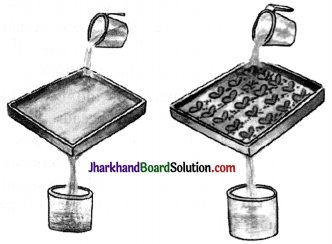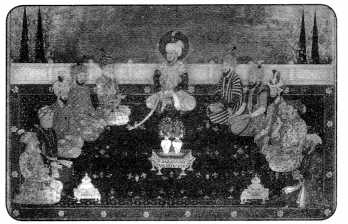JAC Board Class 7th Social Science Solutions Geography Chapter 1 Environment
JAC Class 7th Geography Environment InText Questions and Answers
Question 1.
Look at your surroundings. Make a list of uses that the land in your neighbourhood is being put to.
Answer:
The land used in our neighbourhood is being put to parks, roads, places of worships, buildings, institutions, small scale industries, etc.
Question 2.
Where does the water you use in your home and school come from? Make a list of different uses of water in our daily life. Have you seen anyone wasting water? How?
Answer:
The water which we use in our home and school come from rivers, tanks, city water works, taps, etc.
- Different uses of water in our daily life are for drinking, cooking, washing, cleaning, brushing, bathing, growing plants, sewerage disposal.
- Several people waste water in various ways and seen it many times. While brushing teeth, they keep their tap on. Seen overflow of water tanks in many houses, as they forget to check the water. While working in kitchen, washing utensils, they keep tap in full speed and on always.
Observe the sky while coming to school. Make a note whether the day is cloudy, rainy, sunny, foggy, etc. Students need to do it yourself.
Sample answer given below:
The day is sunny. It is not so hot. The sun is shining brightly and the sky is clear and blue and cannot see clouds. We can play outside. The weather is comfortable for swimming.
Page 4
Question 4.
Sketch or bring photographs of your place like the students in the story. Answer: Students need to do it yourself.
![]()
Page 5
Question 5.
Talk to some elderly person in your neighbourhood and collect information about-
- The trees in his/ her neighbourhood when he/ she was your age.
- The indoor games he/she played.
- His/her favourite fruit at your age.
- How did they make themselves comfortable during hot summers and cold winters? Display your answers on a wall/ bulletin board.
Answer:
Students need to do it yourself. Sample answer given below:
- The trees of papaya, mango, guava, coconut, litchi, banana, etc.
- Chess, carrom board, cards, ludo.
- Mango, litchi and coconut.
- During hot summer days they used to sit under huge trees where breeze blows and do swimming in ponds and lakes.
- During cold winter days they used to sit near fire and outside to get sunlight.
JAC Class 7th Geography Environment Textbook Questions and Answers
Question 1.
Answer the following questions.
(i) What is an ecosystem?
Answer:
A system established by the interaction of all living organisms with each other and their surroundings in which they live and interlinked with transfer of energy and material. They are interdependent and called an ecosystem.
(ii) What do you mean by natural environment?
Answer:
Natural environment comprises of land, water, air, plants and animals. Hence, natural environment refers to both biotic and abiotic conditions that exist on the earth.
(iii) Which are the major components of the environment?
Answer:
The major components of the environment are:
- Natural environment (land, air,
- water, living beings)
- Human environment (individual, family, community, educational, economic, religion, etc.)
- Human made environment (parks, buildings, roads, bridges, monuments, etc.)
(iv) Give four examples of human made environment,
Answer:
Four examples of human made environment are parks, roads, monuments, buildings.
(v) What is lithosphere?
Answer:
The solid crust or hard top layer of the earth is called Lithosphere. It is usually made up of rocks and different minerals and covered with thin layer of soil.
![]()
(vi) Which are the two major components of biotic environment?
Answer:
Animals and plants are the two major componenets of biotic environment.
(vii) What is biosphere?
Answer:
The limited section of the earth where land, air and water interact with each other to support life is called biosphere. Hence, animal and plant kingdom together constructs biosphere means the living world.
Tick (√) the correct answer.
Question 2.
(i) Which is not a natural ecosystem?
(a) Desert
(b) Aquarium
(c) Forest
Answer:
(b) Aquarium
(ii) Which is not a component of human environment?
(a) Land
(b) Religion
(c) Community
Answer:
(a) Land
(iii) Which is a human made environment?
(a) Mountain
(b) Sea
(c) Road
Answer:
(c) Road
(iv) Which is a threat to environment?
(a) Growing plant
(b) Growing population
(c) Growing crops
Answer:
(b) Growing population
Question 3.
Match the following.
| (i) Biosphere | (a) blanket of ai? which surrounds the earth |
| (ii) Atmosphere | (b) domain of water |
| (iii) Hydrosphere | (c) gravitational force of the earth |
| (iv) Environment | (d) our surroundings |
| (e) narrow zone where land, water and air interact | |
| (f) relation between the organisms and their surroundings,, |
Answer:
| (i) Biosphere | (e) narrow zone’ where land, water and air interact |
| (ii) Atmosphere | (a) blanket of air which surrounds the earth |
| (iii) Hydrosphere | (b) domain of water |
| (iv) Environment | (d) our surroundings |
Question 4.
Give reasons.
- Man modifies his environment
- Plants and animals depend on each other
Answer:
- Man modifies his environment to fulfill their basic needs and make their own life easy and comfortable. He also modifies to adapt itself ‘ to the natural surroundings and environment.
- Plants and animals depends on each other for their own interests and needs. Plants release oxygen and animals need to breathe it. Animals release carbon dioxide which plants required to breathe.
Activity
Question 5.
Imagine an ideal environment where you would love to live. Draw the picture of your ideal environment.
Answer:
Students need to do it by themselves.
JAC Class 7th Geography Environment Important Questions and Answers
Multiple Choice Questions
Question 1.
…………..is not a component of natural environment.
(a) Region
(b) Air
(c) Land
(d) Water
Answer:
(a) Region
![]()
Question 2.
The atmosphere contains
(a) dust
(b) gas
(c) water vapour
(d) all of these
Answer:
(d) all of these
Question 3.
Human made component of environment is ………
(a) air
(b) water
(c) buildings
(d) none of these
Answer:
(c) buildings
Question 4.
The force which hold earth’s atmosphere is…
(a) pulling force
(b) gravitational force
(c) pushing force
(d) magnetic force
Answer:
(b) gravitational force
Question 5.
The revolution which made communication easier and speedy across the world was
(a) French revolution
(b) Information revolution
(c) Green revolution
(d) Glorious revolution
Answer:
(b) Information revolution
Question 6.
Fifth June is celebrated as
(a) World smile day
(b) World chocolate day
(c) World environment day
(d) None of the above
Answer:
(c) World environment day
Question 7.
Different landforms are a part of
(a) lithosphere
(b) hydrosphere
(c) atmosphere
(d) biosphere
Answer:
(a) lithosphere
Question 8.
Industrial revolution was conducted in the period of
(a) Small scale production
(b) Population growth
(c) Use of money
(d) Large scale production
Answer:
(d) Large scale production
![]()
Question 9.
In French, the word ‘environment’ mean
(a) forest
(b) surrounding
(c) neighbourhood
(d) nature
Answer:
(c) neighbourhood
Question 10.
Hydrosphere comprises of
(a) lakes
(b) sea
(c) river
(d) all of these
Answer:
(d) all of these
Very Short Answer Type Questions
Question 1.
What do you mean by barter system?
Answer:
Barter system is a system or trade in which goods are exchanged without the use of money.
Question 2.
What is the importance of atmosphere?
Answer:
The importance of atmosphere is that it protects us from scorching heat and harmful rays from the sun.
Question 3.
What do you mean by atmosphere?
Answer:
The thin layer of air which surrounds the earth is called as the atmosphere.
Question 4.
What do you mean by hydrosphere?
Answer:
Hydrosphere means the domain of water in the earth.
Question 5.
Why hydrosphere is of great significance?
Answer:
Hydrosphere comprises of water which helps to sustain a great variety of life form. It comprises various sources of water and different types of waterbodies like rivers, lakes, seas, oceans, etc. It is essential for all living organisms.
Question 6.
What do you mean by environment?
Answer:
Environment is our basic life support system. It provides the air we breath, the water we drink, the food we eat and the land where we live. It is a combination of natural and human made phenomena.
![]()
Question 7.
Give names of different types of waterbodies.
Answer:
Different types of waterbodies are lakes, rivers, seas, oceans, etc.
Question 8.
Does Cherrapunji gets heavy rainfall?
Answer:
Yes, Cherrapunnji gets heavy rainfall.
Question 9.
Which kind of animals do you find in desert?
Answer:
The kind of animals we find in deserts are camels, lizards, snakes and different types of insects.
Question 10.
Where do we find landforms?
Answer:
We find landforms over the continents and ocean floors.
Short Answer Type Questions
Question 1.
Do you think our environment is changing? Justify your answer.
Answer:
Our environment is changing very fast because our needs are increasing day by day and in order to fulfill these needs we are modifying and at times even destroying our natural surroundings.
![]()
Question 2.
What is the difference between biotic and abiotic environment.
Answer:
Biotic environment comprises of all the living organisms such as animals and plants. Abiotic environment comprises of all non-living components such as air, water, land. ‘
Question 3.
Why human beings are makingchanges in their environment?
Answer:
Human changes or made alterations of his environment according to his needs and demands. With time needs and demands grew and became more varied and wide. Human beings started learning new ways to use and change the environment. Hence, they leamt to grow crops and started harvesting, domesticate animals and lead a settled life.
Question 4.
What are the three major components of the environment which are collectively known as biosphere?
Answer:
The three major components of the environment which are collectively known as biosphere are atmosphere, lithosphere and hydrosphere.
Question 5.
Which gas human beings and plants use to sustain in the environment?
Answer:
Human beings use oxygen and plants use carbon dioxide to sustain in the environment. Plants uses carbon dioxide to make their food and releases oxygen. Human or animals releases carbon dioxide.
![]()
Question 6.
What is the importance of oxygen in air?
Answer:
The importance of oxygen in air is that humans and animals need it to breathe and sustain. Without oxygen life cannot sustain. It is the second most in quantity in’ air.
Question 7.
What are the differences between lithosphere and atmosphere?
Answer:
Differences between lithosphere and atmosphere:
Lithosphere
- The solid crust or the hard top layer of the earth is called as lithosphere.
- Grasslands, lands, forests, human settlements are a part of lithosphere.
Atmosphere
- The thin layer of the air that surrounds the earth is called as atmosphere.
- Atmosphere safeguard us from scorching heat and harmful ultra violet rays.
Question 8.
How does the ecosystem work?
Answer:
Each and every ecosystem is formed by the interaction between all living beings with each other and with the environment in which they live. The connection between biotic and abiotic elements of an ecosystem happen due to the transfer of energy. They are interdependent on each other.
![]()
Question 9.
Biosphere has a great impact on human beings? What are they?
Answer:
Biosphere has a great impact on human beings.
They are as follows:
- It provides us our basic necessities of our life such as food, air, water, etc.
- It provides us natural resources like fuel, energy, plants, minerals, etc.
- It also provides us raw material for industries.
Question 10.
What do you understand by biodiversity?
Answer:
In our solar system, earth is the only planet where life sustains. Over period of time, life evolved and got diversified. Different types of species came into existence due to diversification process of nature. This wide range of species are called as biodiversity.
Long Answer Type Questions
Question 1.
Should we protect our environment? Justify your answer.
Answer:
Yes, we should protect our environment due to the following reasons:
- It is our fundamental life support system. It provides us the air which we breathe, water which we drink and do cleaning works and land where we live.
- It provides us many natural resources such as minerals, wood, fuel, etc.
- By unwise use of resources such as forests, farms, pastures, hills, most of the parts of the environment has been badly affected and damaged.
- The different activities of the human beings effects the environment in one way or the other.
- If we don’t control now, then the problems which we will face will be very dangerous and irreparable like we don’t get enough rainfall where it is required hence crops and harvesting gets affected.
Question 2.
Is environment static or dynamic? Human beings have adapted and changed the environment accordingly to fulfill their needs. Explain briefly.
Answer:
Our environment is dynamic and not static. Different natural, external and human factors bring many changes in the environment.
- Human beings have adapted to the environment and changed it to fulfill their needs and requirements:
- Early humans led a simple life and fulfilled their needs from the surrounding nature. They adapted easily to the nature around them.
- The human beings started using variety of things and their needs kept increasing.
- To meet the requirements and needs, human beings learnt to grow crops, domesticate the animals and started to live a settled life.
- Excess food and grains was produced. Hence, trade emerged with the rise of barter system.
- Transport and agricultural needs ‘ were fulfilled by the invention of ’ wheels.
- Also means of communication developed.
- Human beings are using the natural resources beyond their needs and wasting it most of the time.
- Due to human activities environmental degradation occurred.
- Hence, human beings should mark this as his duty to maintain the environmental balance and stability.





